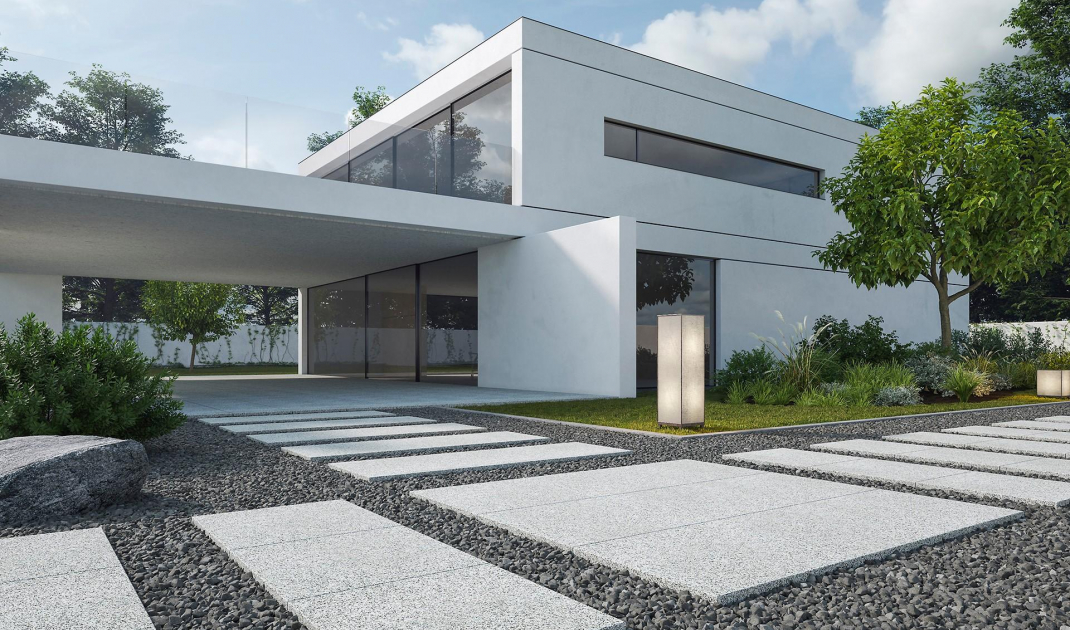Granite is a unique building and decorative material. Every part of this natural stone is different and unique. All the scratches, cracks and flecks show the time and geological processes that have influenced its final appearance for millions of years. How to use this material in the garden?
How is granite formed?
Granite for use in the garden is usually obtained as finished slabs, blocks or pebbles, which are used to build paths, terraces, walls or other garden design elements. The material is extracted from quarries. The process involves the removal of large blocks using blasting, heavy machinery or other methods. The mined granite is then processed and prepared for use. Large blocks of material are often cut into smaller slabs or pebbles of specific dimensions. Granite may also be subjected to surface treatments such as polishing or grinding to achieve the desired appearance. It is also important to check that granite sourcing is done in a sustainable and environmentally friendly manner.
Granite is a type of natural stone
© KLINK
Will granite work well in the garden?
Granite has many features that make it an ideal material for use in the garden.
Resistance to scratches and abrasion
Granite is difficult to scratch. Its hard texture makes it resistant to common factors that can cause scratches, such as contact with sharp tools, stones or metal objects. Granite is also resistant to abrasion. It is durable and long-lasting, making it an ideal material for use in the garden.
Resistance to weathering
Granite is also resistant to weathering, such as water, frost and sunlight. Its hard structure provides durability and resistance to erosion.
Maintenance
Granite is a durable rock, but it may require some maintenance in the garden. Regular cleaning, stain removal or weatherproofing can help keep it in good condition for years to come.
Because of its features, granite will be ideal for the garden
© KLINK
How to use granite in the garden?
Garden palisades
Granite palisades are the best solution if you appreciate lush vegetation, colorful seedlings, but at the same time want the garden to be clean, orderly and harmonious. Sturdy construction and properly selected height make flowers and shrubs well protected and separated from usable space, protecting plants from damage. One palisade can weigh almost 27 kilograms - a strong construction will surely survive all inconveniences and unfavorable weather conditions. Garden palisades will not only work well as edging for flower beds, but also as reinforcement of garden paths, providing them with structural support and an elegant appearance. Granite palisades are very easy to keep clean, just rinse off the dust and dirt with a garden hose to keep their beautiful and natural appearance.
Granite pavers
How line the paths in the garden? Granite paving blocks are a guarantee of durability. The surface will be able to withstand even the harshest weather conditions. Rain, snow or intense sunlight will not have a negative impact on the quality and appearance of the granite path. This will avoid repairs and maintenance. This is one of the most important features of this material. In addition, the durability of this unique material and resistance to abrasion, make the granite path very safe. Ordinary ceramic tiles or wood are aesthetically pleasing, but they are not the best choice for a climate zone characterized by precipitation and frost. An additional advantage of granite pavers is their simplicity in maintenance and cleaning.
Garden palisade made of granite
© KLINK
Terrace made of granite
Granite can be used to build elegant terraces. Using large granite slabs or granite pavers allows you to create a stable surface for relaxing and dining outdoors.
Garden ornaments made of granite
Granite can be used to create striking fountains or ponds in the garden. Thanks to its durability and natural appearance, granite creates striking water features that add elegance and tranquility to a space. Granite stones, blocks or sculptures can be used as decorative elements in the garden. They can decorate squares, create natural compositions or even be used to create water cascades.
Garden furniture
Granite can also be used for garden furniture, such as tables, benches or barbecue tops. Thanks to its durability and aesthetics, granite makes elegant and durable furniture that will please the eye for many years.
Granite is the ideal material for garden paths and walkways
© Granit Naturalny
How much does granite cost?
Granite is considered a higher-quality natural stone and can be slightly more expensive than other materials for the garden. Granite prices are usually quoted per square meter (m²) or per ton (t) for larger blocks or pebbles. In the case of granite slabs, the price can range from about 200 PLN to 1,000 PLN per square meter, depending on the grade of granite, the thickness of the slab and the surface finish (e.g. polished, honed, rough). On the other hand, the price per ton of granite pebbles can range from about 500 PLN to 3,000 PLN. Differences in price are due to differences in granite grade, pebble size and quality.
Are you designing a garden? We have more garden inspiration for you






























